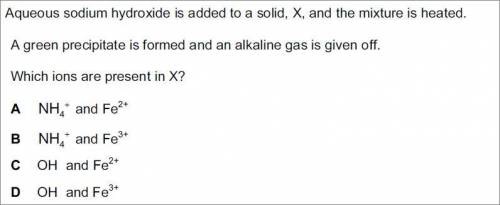
Chemistry, 15.10.2020 07:01 desereemariahha
You have an aqueous solution of chromium(III) nitrate that you titrate with an aqueous solution of sodium hydroxide. After a certain amount of titrant has been added, you observe a precipitate forming. You add more sodium hydroxide solution and the precipitate dissolves, leaving a solution again. What has happened?1) The precipitate was chromium hydroxide, which then reacted with more hydroxide to produce a soluble complex ion, Cr(OH)4?.2) The precipitate was chromium hydroxide, which dissolved once more solution was added, forming Cr3+(aq).3) The precipitate was sodium nitrate, which reacted with more nitrate to produce the soluble complex ion Na(NO3)2?.4) The precipitate was sodium hydroxide, which re-dissolved in the larger volume.


Answers: 2


Other questions on the subject: Chemistry

Chemistry, 22.06.2019 15:30, ricardotavarez6
How does a large body of water, such as the ocean, influence climate?
Answers: 1


Chemistry, 22.06.2019 21:00, andrethisman88
Kp is the equilibrium constant for dissociation of the propionic acid dimer. what is the sign of the slope for a plot of the natural logarithm of kp vs. inverse temperature for this reaction?
Answers: 1

You know the right answer?
You have an aqueous solution of chromium(III) nitrate that you titrate with an aqueous solution of s...
Questions in other subjects:





Mathematics, 27.10.2020 16:20

Mathematics, 27.10.2020 16:20


Mathematics, 27.10.2020 16:20

English, 27.10.2020 16:20



